January – March
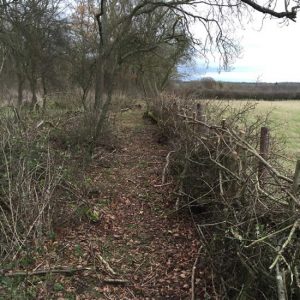 Our Woodland Working parties really got stuck in with some necessary boundary hedge laying during January, None of them had ever done any hedge laying, but they really enjoyed the experience of working together on a shared task, with plenty of stops for coffee, hot chocolate, cake, biscuits and plenty of chat and shared laughter along the way.
Our Woodland Working parties really got stuck in with some necessary boundary hedge laying during January, None of them had ever done any hedge laying, but they really enjoyed the experience of working together on a shared task, with plenty of stops for coffee, hot chocolate, cake, biscuits and plenty of chat and shared laughter along the way.
Our woodland working parties are all about encouraging people to benefit their wellbeing through spending time in the woodland, in all seasons of the year, involving themselves in group-based activity for as much or as little as they feel able.
Over a series of weeks everyone who comes along finds their ability/motivation to do more increases. The knock-on effects have been reported as “enjoying better sleep”, “feeling more positive about life”, “doing something for me!” Certainly the smiles on the faces you see in this picture are a reflection of the smiles that are going on within.
We attract a wide variety of adults to our woodland working parties, ages ranging from mid 20’s to mid 70’s. Age or disability is no barrier to taking part so long 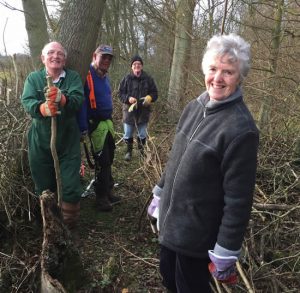 as participants are prepared to negotiate the hazards underfoot that exist in a wild wood environment.
as participants are prepared to negotiate the hazards underfoot that exist in a wild wood environment.
Work undertaken at woodland working parties can range widely according to the season. In the winter theres hedge laying, brash clearance, tree planting and coppicing. In Spring and summer there are plant and tree surveys to be done and waging war on the encroaching brambles over paths and tracks.
However, the most important aspect of a woodland working party is not about the work done but the “party” enjoyed through being in the company of a supportive group. Woodland Working Parties are essentially about being outdoors, getting a little bit fitter, noticing nature, having a laugh with others and most importantly going home smiling from the inside.
You can find out more about Woodland Working Parties at Oxlip Wood. If you like the sound of them for yourself or someone you know then we’ll be happy to welcome you or them to explain in more detail the benefits to be enjoyed. Oh, did I mention the cost? Woodland Working Parties are free…
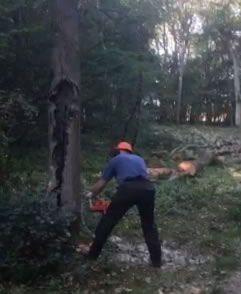 Woodland Management activities at Oxlip Wood
Woodland Management activities at Oxlip Wood
There’s an ongoing woodland management plan running at the wood, requiring a considerable amount of tree felling. Reasons for felling of trees are various. One reason being to open up the tree canopy, allowing more light to reach the woodland floor, to increase biodiversity (encourage a wider range of plants and creatures to inhabit the wood).
The other reasons for tree felling is related to tree health. Unhealthy trees can topple over, especially in windy weather, causing damage to other trees. Unhealthy trees can also pose a hazard to to people attending activities within the wood, so something we need to manage.
If you click on the image to the left you can watch a video illustrating the reality of decline in the health in a tree. In this case you can already see damage to the outside of the tree, but in many cases the tree can look quite normal on the outside. In the video, notice the rotten trunk, clearly visible as the tree hits the ground.
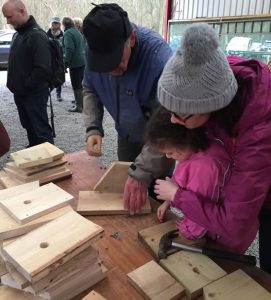 Felling of trees stops in February, before the birds begin to nest. So another job that needs to be done in January is putting up bird boxes ready for new bird families to inhabit.
Felling of trees stops in February, before the birds begin to nest. So another job that needs to be done in January is putting up bird boxes ready for new bird families to inhabit.
We make the bird boxes sections ourselves then invite families to come along to construct them. Our family nest box making session, together with members from the Woodland Working Parties are always well subscribed. Young and old working together on a shared project is wonderful to witness, demonstrating another aspect of our ongoing community objectives, intergenerational practice.
Intergenerational practice aims to bring people together in purposeful, mutually beneficial activities that help promote improved respect between generations, contributing to building better communication and more cohesive communities. In a nutshell, intergenerational practice is all about creating community spirit through everyone feeling they’re playing a useful role in a shared experience.
We also run intergenerational sessions to instil love for trees, designed for children to attend with their families, ably assisted by the older community members who are involved on Woodland Working Parties.
Not only do the children get to plant a tree, but they get to adopt the tree, encouraging them to form a bond with a tree, watching it grow and also providing necessary practical intervention needed to make sure they do! It’s a great way to make children aware that as big as trees can become, they need protection from animals and other plants in their initial growth stages.
The next step we have planned, starting in 2017, is to introduce the children to making something from the wood of the tree variety they have planted. We have run a couple of pilot sessions and will be promoting family sessions on making items from Hazel in the Summer and Autumn. If getting involved in tree planting is of interest to you, your family or others you know then register interest as the first session is in February.
April – June
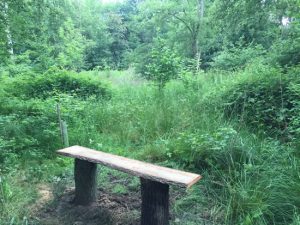 Promoting wellbeing is at the core of Outdoor Tribe’s mission statement and we find the Spring/Summer months provide the best time to encourage new people to sample the health benefits from spending time in woodland. There’s a practice called Woodland Bathing (Sinrun Yoku) that embraces the health benefits to be experienced from just spending time in woodland.
Promoting wellbeing is at the core of Outdoor Tribe’s mission statement and we find the Spring/Summer months provide the best time to encourage new people to sample the health benefits from spending time in woodland. There’s a practice called Woodland Bathing (Sinrun Yoku) that embraces the health benefits to be experienced from just spending time in woodland.
You can read more about Woodland Bathing and maybe consider coming along to one of our wellbeing sessions planned for 2017. Experience woodland bathing as part of our Rejuvenation days, spending some of the time in quiet contemplation listening to the sounds of nature, breathing in the tranquility that exists in the wood. Whether you’re interested as an individual or for a group booking, let us know if you’re interested in Rejuvenation sessions and we’ll keep you posted with available dates as soon as they’re published.
April and May are also particularly popular with visitors who love to see the Bluebells that carpet most of the woodland. Often there are wild Orchids to be discovered too, along with Oxlips, Cowslips and a considerable number of other wild flowers.
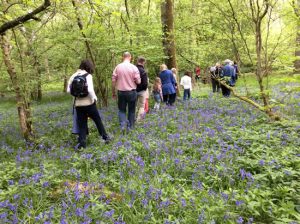 During the Bluebell season we provide guided tours on our open days, published on our Events page from the beginning of April.
During the Bluebell season we provide guided tours on our open days, published on our Events page from the beginning of April.
For groups of visitors who want to arrange a visit for themselves alone we can combine a visit with provision of tea and biscuits, or even a light lunch if required.
Although there are many places that are not suitable for wheelchairs, it is possible to enjoy the Bluebells from one of the main tracks that provide suitable access to the centre of the wood.
Whether you’re an individual or considering a visit for a group you are involved with, If you’re interested in visiting the wood during Bluebell time then please contact us.
July – September
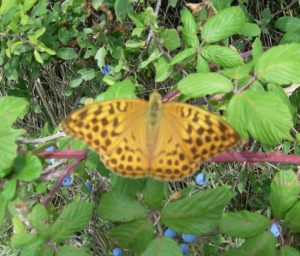 Butterflies abound in the wood, particularly in July and August, and provide some wonderful photo and painting opportunities for groups of visitors.
Butterflies abound in the wood, particularly in July and August, and provide some wonderful photo and painting opportunities for groups of visitors.
Gerald Collini has had a lifelong interest in British butterflies and loves to share his passion for them with other like-minded people.
If watching butterflies in a beautiful, tranquil woodland that remains undisturbed for most of the time is an appealing prospect then get in touch and let us know which butterflies you’re particularly interested in observing. We can soon tell you whether you’re likely to see what you’re particularly interested in seeing.
We run half-day sessions for groups of interested butterfly enthusiasts and can provide refreshments for groups if required.
For the last couple of years we’ve taken part in the Nene Valley Festival running woodland activity taster sessions for families.
Susan Collini is a Level 3 Forest School Leader (meaning Susan is qualified to run a Forest School in the woodland). We run Forest School taster sessions throughout the year, prior to blocks of 6 weekly Forest School sessions for children. Find out more about Forest School and the benefits it has to offer children.
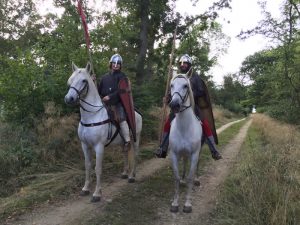 During the 2016 Nene Valley Festival we also ran a Heritage Walk for adults to enjoy and were delighted that a number of our local community got involved with entertaining the visitors with readings and drama-based presentations. The woodland dates back to the 1320’s so there was a lot of heritage to choose from!
During the 2016 Nene Valley Festival we also ran a Heritage Walk for adults to enjoy and were delighted that a number of our local community got involved with entertaining the visitors with readings and drama-based presentations. The woodland dates back to the 1320’s so there was a lot of heritage to choose from!
On the day of the Heritage walk visitors were drawn into the heritage of the wood by a short presentation given by a local village resident.
The story of a changing historical landscape involving Kings and the their feuding underlings kept the visitors enthralled. Then arrival of Knights in full armour on horseback, thundering up through the woodland towards them, quite simply made them squeal with delight
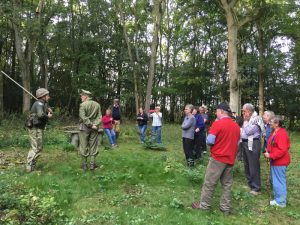 Further along the walk visitors came across a Dad’s Army entertainment alongside what we call the Home Guard tree, where a platform remains that was used as a look-out by the Home Guard during WW2.
Further along the walk visitors came across a Dad’s Army entertainment alongside what we call the Home Guard tree, where a platform remains that was used as a look-out by the Home Guard during WW2.
Once again, local village residents rose to the challenge of communicating Home Guard and woodland related fact in an entertaining and engaging way,
The enthusiastic entertainers even managed to combine past and present in an exchange between Cpt. Mainwaring and a present day soldier in full uniform who’d got somewhat lost in the trees “stupid boy”!
I have to say we were absolutely thrilled by Outdoor Tribe’s 2016 Nene Valley Festival event as much as the audience and felt it was a triumph in community involvement, an important aspect of what Outdoor Tribe is all about.
October – December
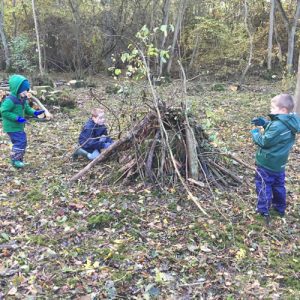 Woodland Management by the Woodland Working Parties, Forest School Taster sessions and general woodland infrastructure repairs and renewals generally take place during these months of the year.
Woodland Management by the Woodland Working Parties, Forest School Taster sessions and general woodland infrastructure repairs and renewals generally take place during these months of the year.
As the animals and mini-beasts seek cosy shelters for the winter we encourage families to do the same in their own gardens, running sessions to build awareness and actual mini-beast homes to take home.
During Forest School sessions we encourage the children to get involved in building conservation heaps within the woodland.
Conservation heaps provide shelter for the bugs and small creatures that will emerge the following Spring to provide us all with hours of observations delight once again.
A woodland has so much to offer everyone to benefit their wellbeing which is why in 2017 we’re hoping to extend our range of activities to include a wider range of user groups. We hope we’ll get to meet you, or see you again soon.

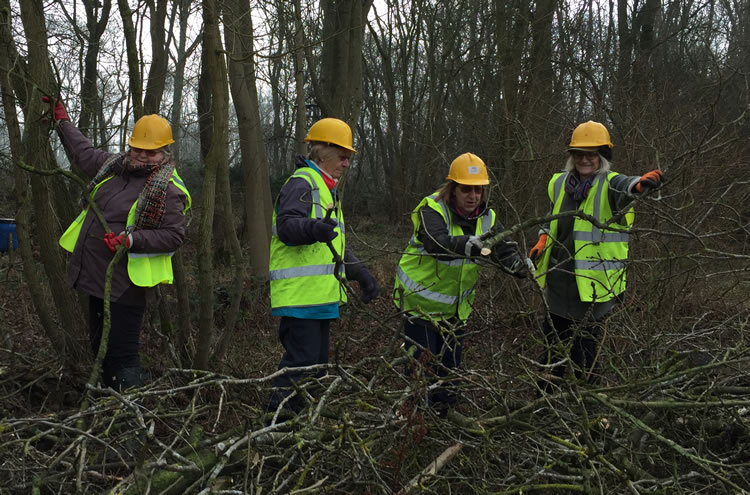
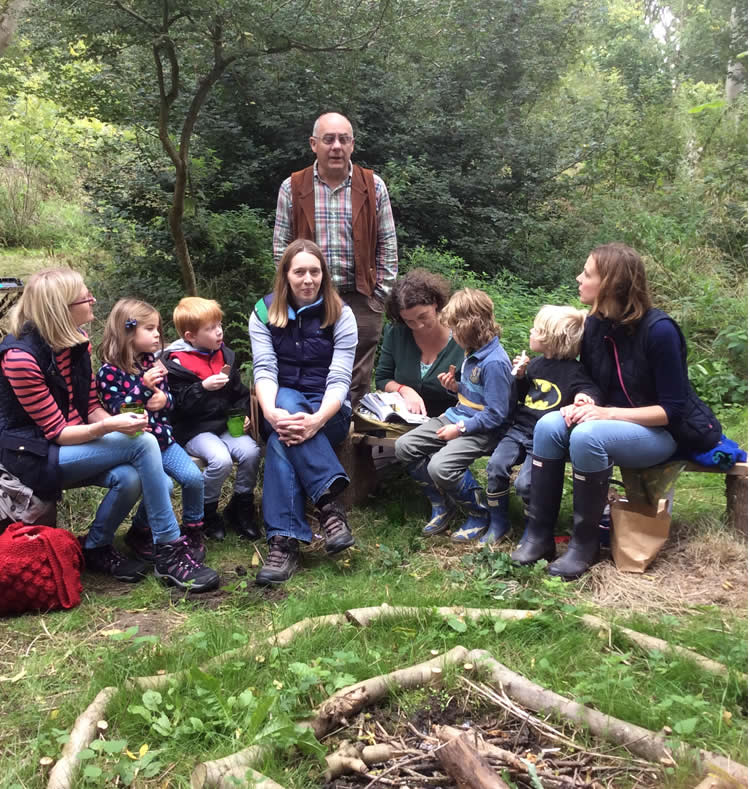

Recent Comments